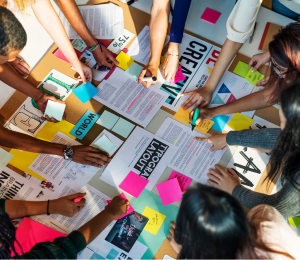Social media burnout scale: Factor structure confirmation in the brazilian context
Social media burnout scale: Confirmación de su estructura factorial en el contexto brasileño
DOI:
https://doi.org/10.17081/psico.27.52.6392Palabras clave:
social networks, internet, burnout, self-assessment scale, validation, psychometryResumen
Objective: The aim of this study was to confirm the structure of the Social Media Burnout Scale (SMBS) in the Brazilian context.
Method: This is a psychometric study of a quantitative approach. Participants were 419 individuals from the general population, mostly college students, aged between 18 and 57 years (M =24,77; SD =6,75). Participants also answered a sociodemographic questionnaire, the Social Media Burnout Scale, and the Burnout Syndrome Assessment Scale in University Students (BSAS-us). Data were analyzed using the software JASP.
Results: The results showed that the three-factor model of the SMBS had satisfactory fit indices in the Brazilian sample (χ²=77,75, df=32, CFI =0,97, TLI=0,97, RMSEA=0,05, 95%CI=0,04-0,07, SRMR=0,06). In addition, the three factors presented acceptable McDonald’s Omegas. Finally, the factor Exhaustion from the SMBS and Physical and the factor Emotional Exhaustion from the BSAS-us were correlated with r=0,32 (p<0,001), demonstrating convergent validity.
Discussion: The measure with the Portuguese name Escala de Burnout de Redes Sociais (EBRS) is the first valid and reliable measure to study the phenomenon in the Brazilian context.
Descargas
Citas
Bright, L. F., Kleiser, S. B., & Grau, S. L. (2015). Too much Facebook? An exploratory examination of social media fatigue. Computers in Human Behavior, 44, 148-155. https://doi.org/10.1016/j.chb.2014.11.048
Brown, T. (2015). Confirmatory Factor Analysis for Applied Research (2a ed.). Guilford Press.
Carlotto, M. S., & Câmara, S. G. (2020). Burnout Syndrome Assessment Scale in University Students: construction and validity evidence, Society and Development, 9(7), e171974013. https://doi.org/10.33448/rsd-v9i7.4013
Chen, F. F. (2007). Sensitivity of goodness of fit indexes to lack of measurement invariance. Structural Equation Modeling, 14, 464-504. https://doi. org/10.1080/10705510701301834
Cheung, G. W., & Rensvold, R. B. (2002). Evaluating Goodness-of-Fit Indexes for Testing Measurement Invariance. Structural Equation Modeling: A Multidisciplinary Journal, 9(2), 233-255. https://doi.org/10.1207/S15328007SEM0902_5
Cohen, J. (1988). Statistical power analysis for the behavioral sciences (2nd ed.). Lawrence Erlbaum.
Conselho Nacional de Saúde. (2016). Resolução n.º 510, de 7 de abril de 2016. Ministério da Saúde. http://conselho.saude.gov.br/resolucoes/2016/Reso510.pdf
Distefano, C., & Morgan, G. B. (2014). A Comparison of Diagonal Weighted Least Squares Robust Estimation Techniques for Ordinal Data. Structural Equation Modeling, 21(3), 425-438. https://doi.org/10.1080/10705511.2014.915373
Ercan, I., Yazici, B., Sigirli, D., Ediz, B., & Kan, I. (2007). Examining Cronbach alpha, theta, omega reliability coefficients according to sample size. Journal of modern applied statistical methods, 6(1), 291-303. https://doi.org/10.22237/jmasm/1177993560
Fisher, J. T., & Weber, R. (2020). Limited capacity model of motivated mediated message processing (LC4MP). In J. Van Den Bulck (Ed.), International Encyclopedia of Media Psychology (pp. 1-11). Wiley Blackwell.
Hair, J., Black, W., Babin, B., Anderson, R., & Tatham, R. (2014). Multivariate data analysis (7th ed.). Pearson New International Edition/Prentice Hall.
Han, B. (2018). Social media burnout: Definition, measurement instrument, and why we care. Journal of Computer Information Systems, 58(2), 122-130. https://doi.org/10.1080/08874417.2016.1208064
Harren, N., Walburg, V., & Chabrol, H. (2021). Studying Social Media Burnout and Problematic Social Media use: The implication of perfectionism and metacognitions. Computers in Human Behavior Reports, 4, 100117. https://doi.org/10.1016/j.chbr.2021.100117
Hu, L., & Bentler, P. M. (1999). Cutoff criteria for fit indexes in covariance structure analysis: Conventional criteria versus new alternatives. Structural Equation Modeling, 6(1), 1-55. https://doi.org/10.1080/10705519909540118
Izquierdo, M. G., & Velandrino, A. P. (1992). EPB: Una escala para la evaluación del burnout profesional de las organizaciones. Anales de Psicología, 8(1-2), 131-138. https://revistas.um.es/analesps/article/view/28821
Kristensen, T. S., Borritz, M., Villadsen, E., & Christensen, K. B. (2005). The Copenhagen Burnout Inventory: A new tool for the assessment of burnout. Work & stress, 19(3), 192-207. https://doi.org/10.1080/02678370500297720
Lang, A. (2000). The Limited Capacity Model of Mediated Message Processing. Journal of Communication, 50(1), 46-70. https://doi.org/10.1111/j.1460-2466.2000.tb02833.x
Leiter, M. P., Maslach, C., & Frame, K. (2015). Burnout. The Encyclopedia of Clinical Psychology, 1-7. https://doi.org/10.1002/9781118625392.wbecp142
Li, C. H. (2016). Confirmatory factor analysis with ordinal data: Comparing robust maximum likelihood and diagonally weighted least squares. Behavioral Research Methods, 48(3), 936-49. https://doi.org/10.3758/s13428-015-0619-7
Liu, C., & Ma, J. (2018). Social media addiction and burnout: The mediating roles of envy and social media use anxiety. Current Psychology, 39, 1883-1891. https://doi.org/10.1007/s12144-018-9998-0
Ma, J., & Liu, C. (2021). Psychometric properties of the Chinese version of the social media burnout scale. Current Psychology, 40(7), 3556-3561. https://doi.org/10.1007/s12144-019-00304-y
Maslach, C., & Leiter, M. P. (1997). The truth about burnout. Jossey-Bass.
Maslach, C., & Leiter, M. P. (2008). Early predictors of job burnout and engagement. Journal of Applied Psychology, 93(3), 498-512. https://doi.org/10.1037/00219010.93.3.498
Maslach, C., Jackson, S. E., & Leiter, M. P. (1996). Maslach Burnout Inventory Manual (3th ed.). Consulting Psychology Press.
Pasquali, L. (2009). Psicometria: teoria dos testes na psicologia e na educação (3th ed.). Vozes.
Pasquali, L. (2020). TRI-Teoria de resposta ao item: Teoria, procedimentos e aplicações. Appris.
Ravinder, E. B., & Saraswathi, A. B. (2020). Literature Review of Cronbach Alpha Coefficient (Α) And Mcdonald’s Omega Coefficient (Ω). European Journal of Molecular & Clinical Medicine, 7(6), 2943-2949. https://ssrn.com/abstract=4443362
Shi, C., Yu, L., Wang, N., Cheng, B., & Cao, X. (2020). Effects of social media overload on academic performance: A stressor-strain-outcome perspective. Asian Journal of Communication, 30(2), 179-197. https://doi.org/10.1080/01292986.2020.174 8073
Statista Research Department. (2022a). Worldwide digital population. https://www.statista.com/statistics/617136/digital-population-worldwide/
Statista Research Department. (2022b). Leading social media platforms in Brazil 2021, by reach. https://www.statista.com/statistics/1307747/social-networks-penetration-brazil/
Statista Research Department. (2022c). Countries with the highest number of internet users 2022. https://www.statista.com/statistics/262966/number-of-internet-users-in-selected-countries/
Syvertsen, T. (2020). You are the problem! Everybody online and self-regulation. In Digital detox: The Politics of disconnecting (society now) (pp. 49-71). Emerald Publishing Limited. https://doi.org/10.1108/978-1-78769-339-520201004
Zhang, S., Shen, Y., Xin, T., Sun, H., Wang, Y., Zhang, X., & Ren, S. (2021). The development and validation of a social media fatigue scale: From a cognitive-behavioral-emotional perspective. PLOS ONE, 16(1), e0245464. https://doi.org/10.1371/journal.pone.0245464
Zheng, H., & Ling, R. (2021). Drivers of social media fatigue: A systematic review. Telematics and Informatics, 64, 101696. https://doi.org/10.1016/j.tele.2021.101696
Publicado
Cómo citar
Número
Sección
Licencia
Derechos de autor 2025 Layrtthon Carlos de Oliveira Santos, Gleidson Diego Lopes Loureto , Isabella Leandra Silva Santos

Esta obra está bajo una licencia internacional Creative Commons Atribución 4.0.
Desde la revista Psicogente impartimos una política de respeto con nuestra comunidad científica incluyendo a nuestros autores. Los autores tienen derecho a un trato respetuoso y atento en el proceso Editorial, que las evaluaciones de sus artículos sean justas, imparciales (para ello la revista procederá con la evaluación doble ciego) y se realicen en un tiempo razonable. Se deberá mantener la confidencialidad y los permisos para proceder con la publicación. Todo cambio solicitado por parte del comité, los pares y el Editor deberán ser explícitos y claramente justificados. Especifica que los autores/as conservarán sus derechos de autor y garantizarán a la revista el derecho de primera publicación de su obra, el cual estará simultáneamente sujeto a la Licencia de reconocimiento de Creative Commons BY que permite a terceros compartir la obra siempre que se indique su autor y su primera publicación a esta revista.
Garantizamos un proceso editorial transparente: desde las acciones de recepción del articulo hasta la validación final del mismo, se hará en comunicación constante con el autor. Las modificaciones en el estado de los artículos, así como las diversas decisiones tomadas sobre él y los tiempos de ejecución empleados se realizarán haciendo uso de la plataforma OJS y de ser necesario en contacto directo a través del correo de autores y de la revista Psicogente. Así mismo se procura la escogencia de Pares revisores idóneos: con perfiles y experiencia que lleven a una avaluación de calidad de cada documento sometido a revisión.





